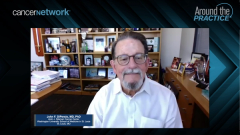
Clinical Scenario 1: First- and Second-Line Treatment for GVHD
John F. DiPersio, MD, PhD, presents the clinical scenario of a 71-year-old patient postmatched unrelated donor HSCT, and the panel discusses first- and second-line treatment approaches including topical and systemic therapies.
Episodes in this series

Transcript:
John F. DiPersio, MD, PhD: I have a case. A 71-year-old man presents postmatched unrelated donor transplant for AML [acute myeloid leukemia]. He had successful engraftment, but 4 months post-transplant he developed acute GVHD [graft-vs-host disease]. The skin required some topical steroids only. He did well until 16 months post-transplant, and then he presented with dry eyes and a skin rash of about 2 months. Patches of thickened skin were around 25% of his trunk. The question is, what are your impressions of this patient case? What GVHD prophylaxis, if any, would you have recommended for this patient getting a matched unrelated donor transplant? What is your center doing with prophylaxis in these patients? Hannah?
Hannah Choe, MD: In the absence of a clinical trial, the patient would get our standard of care, which is tacrolimus-methotrexate. Because this is a reduced-intensity conditioning trial for a patient over the age of 70 years old, we’re certainly doing reduced intensity. That may depend on the results of the BMT CTN 1703 trial becoming PTCy [post-transplant cyclophosphamide], assuming the patient has no additional cardiac risk factors. Otherwise, it would be tacrolimus-methotrexate.
John F. DiPersio, MD, PhD: Does anybody else have any other ideas?
Pashna N. Munshi, MD: I’ve been very comfortable using post-transplant cyclophosphamide in most of my patients. In older patients, I like to select bone marrow graft to mitigate any cytokine-release syndrome toxicities. Also, who wants chronic GVHD? We have treatments, but the best is to prevent it. I’ve been very comfortable using PTCy even in the older patients’ unrelated donor grafts.
John F. DiPersio, MD, PhD: Yi-Bin, what are you doing?
Yi-Bin Chen, MD: Our standard of care is the same as what Hannah said. It would be for a fully matched donor with reduced-intensity conditioning. It would still be standard tacrolimus-methotrexate outside a clinical trial. As my colleagues at OSU [Ohio State University] stated, I await results of CTN-1703 to see if our standards of care should change.
John F. DiPersio, MD, PhD: The patient has presented and has symptoms of dry eyes and progressive dryness and scaliness of the skin. What do you do? Presumably, the patients at that time are off immunosuppression. What do you do for the patient, Pashna?
Pashna N. Munshi, MD: Of course, if you can get away with some topical therapy, it’s best to avoid systemic therapy in these patients. But once you have 2 or more organs involved, you’re probably going to need to start them on some form of systemic therapy eventually. If it’s a simple red rash, if it’s mild—involving less than 50% of body surface area—then I’d try to work with steroids, topical cortisone ointments, and something for your eyes. We often tell them to try Restasis first…but a lot of them don’t tolerate those; otherwise, we use normal artificial tears. If it continues to progress very quickly, we have to think of adding oral steroids.
John F. DiPersio, MD, PhD: On oral steroids, let’s say the patient is improving slightly and then progresses again. Hannah, what’s your next step in patients who fail a month of oral steroids?
Hannah Choe, MD: We really try to get these patients on clinical trials to get them the best option if there is a frontline trial. Most trials right now are first refractory, so we tend to go to the FDA-approved drugs. This would be generally ruxolitinib or belumosudil depending on cost, availability, tolerance. We’re using ruxolitinib as first-line first-year refractory chronic GVHD, evaluating for response regularly, and then evaluating for second-line therapy initiation.
John F. DiPersio, MD, PhD: Is anybody using Rituxan in this setting?
Pashna N. Munshi, MD: Not quite up front. I don’t know if Yi-Bin uses it often, but certainly I’d suggest using it more later on if there are no response here.
John F. DiPersio, MD, PhD: Yi-Bin, what are you doing for this patient that progresses after a month of steroid therapy?
Yi-Bin Chen, MD: Our standard is ruxolitinib. We’ve found that to be the most efficacious and tolerable option. We have a very low threshold to add ruxolitinib these days. What’s interesting is that the definition of steroid-refractory chronic graft-vs-host disease is somehow like shades of gray. What does that mean? As all of us know, the spectrum of a partial response by the NIH [National Institutes of Health] criteria can be very meaningful or not meaningful at all. For a lot of my patients, they may qualify as a partial response to steroids, but it’s not satisfactory to them or me in terms of the response. Adding ruxolitinib at that point to get a better partial response, as well as to be able to taper steroids faster, would be good reason to do so. I have a very low threshold to move on from steroids and use ruxolitinib as our standard second-line agent.
Transcript edited for clarity.
Newsletter
Stay up to date on recent advances in the multidisciplinary approach to cancer.






















































































